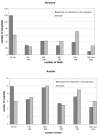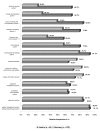IT adoption of clinical information systems in Austrian and German hospitals: results of a comparative survey with a focus on nursing
- PMID: 20122275
- PMCID: PMC2830164
- DOI: 10.1186/1472-6947-10-8
IT adoption of clinical information systems in Austrian and German hospitals: results of a comparative survey with a focus on nursing
Abstract
Background: IT adoption is a process that is influenced by different external and internal factors. This study aimed1. to identify similarities and differences in the prevalence of medical and nursing IT systems in Austrian and German hospitals, and2. to match these findings with characteristics of the two countries, in particular their healthcare system, and with features of the hospitals.
Methods: In 2007, all acute care hospitals in both countries received questionnaires with identical questions. 12.4% in Germany and 34.6% in Austria responded.
Results: The surveys revealed a consistent higher usage of nearly all clinical IT systems, especially nursing systems, but also PACS and electronic archiving systems, in Austrian than in German hospitals. These findings correspond with a significantly wider use of standardised nursing terminologies and a higher number of PC workstations on the wards (average 2.1 PCs in Germany, 3.2 PCs in Austria). Despite these differences, Austrian and German hospitals both reported a similar IT budget of 2.6% in Austria and 2.0% in Germany (median).
Conclusions: Despite the many similarities of the Austrian and German healthcare system there are distinct differences which may have led to a wider use of IT systems in Austrian hospitals. In nursing, the specific legal requirement to document nursing diagnoses in Austria may have stimulated the use of standardised terminologies for nursing diagnoses and the implementation of electronic nursing documentation systems. Other factors which correspond with the wider use of clinical IT systems in Austria are: good infrastructure of medical-technical devices, rigorous organisational changes which had led to leaner processes and to a lower length of stay, and finally a more IT friendly climate. As country size is the most pronounced difference between Germany and Austria it could be that smaller countries, such as Austria, are more ready to translate innovation into practice.
Figures





Similar articles
-
Innovative Power of Health Care Organisations Affects IT Adoption: A bi-National Health IT Benchmark Comparing Austria and Germany.J Med Syst. 2017 Feb;41(2):33. doi: 10.1007/s10916-016-0671-6. Epub 2017 Jan 4. J Med Syst. 2017. PMID: 28054195
-
ICT supporting nurses and physicians in hospitals: results of a comparative survey in Austria and Germany.Stud Health Technol Inform. 2009;146:20-4. Stud Health Technol Inform. 2009. PMID: 19592802
-
Current and future use of ICT for patient care and management in German acute hospitals--a comparison of the nursing and the hospital managers' perspectives.Methods Inf Med. 2005;44(4):528-36. Methods Inf Med. 2005. PMID: 16342920
-
[Reform of emergency physician training in Austria : Finally up to date?].Anaesthesist. 2018 Feb;67(2):135-143. doi: 10.1007/s00101-017-0387-0. Anaesthesist. 2018. PMID: 29209788 Review. German.
-
Liability risks in gynaecology and obstetrics under German and Austrian law.Med Law. 1995;14(5-6):413-23. Med Law. 1995. PMID: 8868500 Review.
Cited by
-
Quality of human-computer interaction--results of a national usability survey of hospital-IT in Germany.BMC Med Inform Decis Mak. 2011 Nov 9;11:69. doi: 10.1186/1472-6947-11-69. BMC Med Inform Decis Mak. 2011. PMID: 22070880 Free PMC article.
-
Innovative Power of Health Care Organisations Affects IT Adoption: A bi-National Health IT Benchmark Comparing Austria and Germany.J Med Syst. 2017 Feb;41(2):33. doi: 10.1007/s10916-016-0671-6. Epub 2017 Jan 4. J Med Syst. 2017. PMID: 28054195
-
Comparison of the Risk of Gastrointestinal Bleeding among Different Statin Exposures with Concomitant Administration of Warfarin: Electronic Health Record-Based Retrospective Cohort Study.PLoS One. 2016 Jul 7;11(7):e0158130. doi: 10.1371/journal.pone.0158130. eCollection 2016. PLoS One. 2016. PMID: 27386858 Free PMC article.
-
Hospital contextual factors affecting the implementation of health technologies: a systematic review.BMC Health Serv Res. 2021 May 1;21(1):407. doi: 10.1186/s12913-021-06423-2. BMC Health Serv Res. 2021. PMID: 33933068 Free PMC article.
-
Citation analysis of the prognosis of Haux et al. for the year 2013.J Med Syst. 2014 Jul;38(7):71. doi: 10.1007/s10916-014-0071-8. J Med Syst. 2014. PMID: 24951046
References
-
- Poon EG, Jha1 AK, Christino M, Honour MM, Fernandopulle R, Middleton B, Newhouse J, Leape L, Bates DW, Blumenthal D, Kaushal R. Assessing the level of healthcare information technology adoption in the United States: a snapshot. BMC Medical Informatics and Decision Making. 2006;6:1. doi: 10.1186/1472-6947-6-1. - DOI - PMC - PubMed
-
- Jiang G, Ogasawara K, Endoh A, Sakurai T. Comparison of Computer-based Information Support to Clinical Research in Chinese and Japanese Hospitals. Methods Inf Med. 2002;41:141–6. - PubMed
-
- Amarasingham R, Diener-West M, Plantinga L, Cunningham AC, Gaskin DJ, Powe NR. Hospital characteristics associated with highly automated and usable clinical information systems in Texas, United States. BMC Medical Informatics and Decision Making. 2008;8:39. doi: 10.1186/1472-6947-8-39. - DOI - PMC - PubMed
-
- eBusinessw@tch/EU Commission. ICT and e-Business in Hospital Acitivities - ICT Adoption and e-Business Activity in 2006. Sector Report. 2006. http://www.ebusiness-watch.org/studies/sectors/health_hospital/documents... (last accessed Jan 20th, 2010)
Publication types
MeSH terms
LinkOut - more resources
Full Text Sources
Molecular Biology Databases
Research Materials

